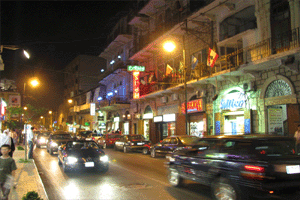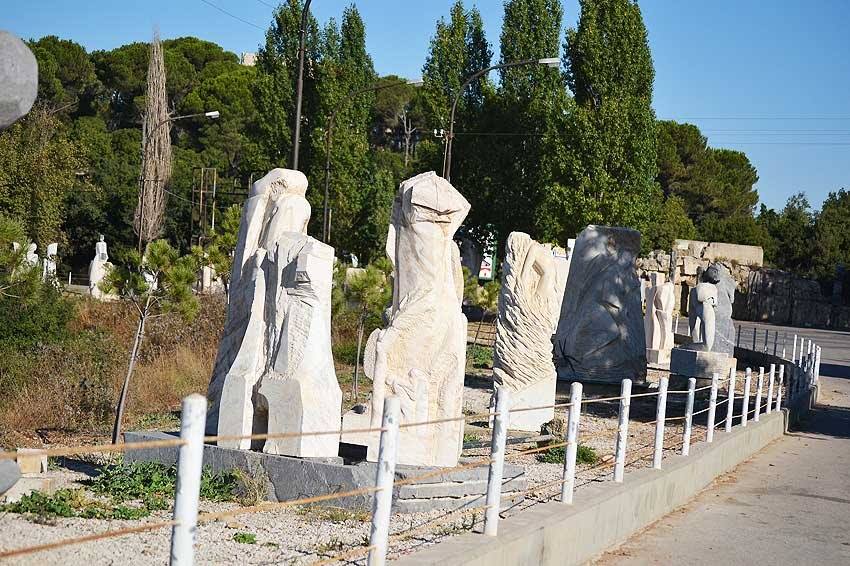Aley residents wanted the 66 artists who participated in the town’s international sculpting symposium this month to feel right at home. Shopkeepers, restaurant owners and even taxi drivers offered their services free of charge to what they saw as an important move toward reviving their once-thriving community.
“The artists being here is important not just for us but for all of Lebanon,” said Omar Aridi, who offered the artists free ice cream during their stay. “Their work, which they donated to the municipality, is going to bring in a lot of tourists, so offering them small gifts is the least we can do.”
Habib Badawi, who owns an Arabic sweet shop in the souk, refused to take money from the sculptors whenever they came in. “They’re VIPs here so of course they get special treatment,” he said. Restaurants invited symposium participants to dinner every night, hotels offered them rooms at half-price and some taxis chauffeured the artists around the town free of charge.
And every evening, residents showed up at the work site on a hill overlooking the town and stayed until the early hours of the morning watching the sculptors at work.
Among those who admired the artwork was Mayor Wajdi Mrad. It was his idea to invite sculptors from 22 countries to spend August in Aley.
Mrad marveled at the details in the work they produced. “I’ve always loved art,” he said. “You see these lines running along the side of this piece? Very few sculptors can do that.”
The municipality with help from sponsors such as the Bank of Beirut and the Arab Countries footed most of the cost of the project, including airline tickets and hotel bills.
“Aley has the potential to become known once again as ‘the bride of villages,’” said Mrad. “It just needs some attention.”
Aref Rayyes, a well-known Lebanese artist who comes from Aley, encouraged Mrad to contact the Lebanese Association of artists and sculptors.
“I told them I wanted to hold an exhibition,” he said. “I found out that it’s called a ‘symposium’.”
The first symposium was held in summer 1999 and included only Lebanese sculptors who were invited to use a piece of land that belonged to the municipality as an open-air studio. Today, the site has become a popular meeting place for the people of Aley.
Once the municipality has acquired 300 works of art the mayor says this will be achieved within five years the sculptures will be displayed throughout the town. “We’ll hold these symposiums every year and in time Aley will become known as the town with the most sculptures,” said Mrad.
The sculptors said they were pleased at the reception they received, although some grumbled that 66 artists in one go was a few too many.
“We were really treated well,” said Gulene Der Goghossian, who also teaches art at the Lebanese University. “I was very touched at the hospitality in the souk. As soon as shopkeepers knew I was participating in the symposium, they refused to take money.”
Goghossian sculpted a family in marble, with father, mother and child carved closely together to signify the importance to the community of unity between family members.
Andrey Balashov, a Russian artist, was putting the finishing touches to his sculpture of a pregnant woman in a rocking chair. Wearing a long veil and holding a cat in her lap, she seemed to be looking beyond the horizon.
The woman, Balashov said, was waiting for her husband to return from Palestine. “He was a crusader,” he said Balashov. “He went to Palestine but never came back to her.”
While the piece could fetch a great deal of money, Balashov, like all the other sculptors who participated in the symposium, has donated his work to the municipality.
Balashov had been waiting for a long time for the chance to come to the Middle East and work on his vision. “The money for me here isn’t important,” he said. “What’s important is that I complete this sculpture here, in an Arab country. I did a small version of this once in bronze, but I knew that I could only do the large sculpture here.”
It was also American Jeffrey Hanes’ first time in Lebanon. His sculpture of a huge bubble-like form in polystyrene with a seat inside will be transformed into fiberglass. “This is only a model,” he explained. “The idea is to sit in a space which is quiet and tranquil.”
For Lebanese artist Sana Shawa, the experience “allowed us to share ideas … and it allowed people to see that a woman is also capable of sculpting. They were surprised to find out that women were participating.”




